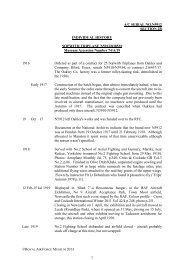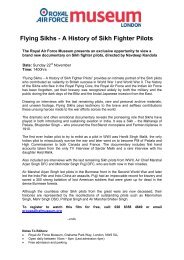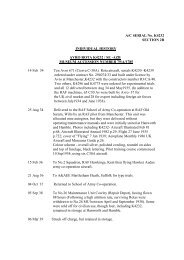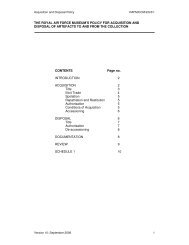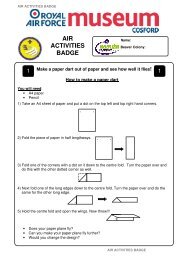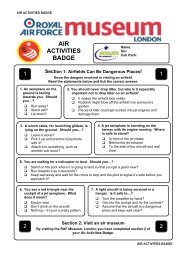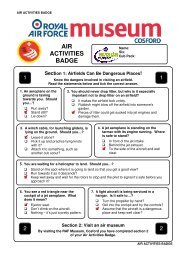Asbestos Policy v1 Jan 2012 - Royal Air Force Museum
Asbestos Policy v1 Jan 2012 - Royal Air Force Museum
Asbestos Policy v1 Jan 2012 - Royal Air Force Museum
- No tags were found...
Create successful ePaper yourself
Turn your PDF publications into a flip-book with our unique Google optimized e-Paper software.
7. Inspection and Labelling of ACMsFormal re-inspections of known or suspected ACMs (based upon the <strong>Asbestos</strong>Register) will be carried out by the <strong>Asbestos</strong> Consultant and will be arranged andco-ordinated by the appropriate <strong>Asbestos</strong> Manager. Re-inspection findings will beused to update the <strong>Asbestos</strong> Register and subject to formal risk assessment. Theperiod between inspections will be set by the <strong>Asbestos</strong> Managers, taking intoconsideration a review of current risk assessments and previous inspection history.ACMs with higher score may be subject to more regular re-inspection than thosewith lower scores.Where ACMs are in good condition, with minimal potential for fibre release, theymay be left in-situ. The designated <strong>Asbestos</strong> Manager is responsible for ensuringthese materials are kept in a sound condition, but ACMs left in-situ will be subject toan inspection regime. The <strong>Asbestos</strong> Manager will determine the inspection period,likely to be 6 or 12 months dependent on the risk assessment.Labelling with standard ‘asbestos warning labels’ or fixing of appropriate warningsignage will be carried out for all known accessible ACMs considered to be ofsignificant risk where this will prevent accidental damage and not cause undueconcern.Labelling of lower risk materials, for example, floor tiles, gaskets, may not be carriedout if other control mechanisms (e.g. site awareness) are considered adequate inpreventing accidental exposure.8. Improvement Works and Removal of <strong>Asbestos</strong> MaterialsWhere an ACM sustains minor damage, simple repair and/or sealing(encapsulation), may be appropriate. The technique and materials used will bedependent on the ACM and may include over-cladding or use of liquid appliedencapsulates. These encapsulates are typically polymeric applications which dry togive a robust water resistant surface. Work on materials requiring an asbestoslicense will only be completed by a licensed asbestos contractor.The term ‘removal’ is used to describe both the removal of bulk materials and thedecontamination of areas where debris or trace asbestos contamination has beenidentified.Removal of ACMs is carried out as a result of:Such work being required by an <strong>Asbestos</strong> Manager;Recommended works related to planned projects;Unplanned circumstances (for example, identification of high risk ACMs,damage to ACMs, arising from maintenance or building works andunforeseen).The option to remove ACMs will be authorised by:HEALTH & SAFETY AT WORK Issue – 01/01/<strong>2012</strong>7



